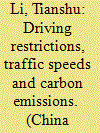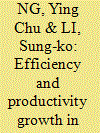| Srl | Item |
| 1 |
ID:
175897


|
|
|
|
|
| Summary/Abstract |
The growing capacity of intermittent energy sources causes more frequent system imbalances as well as congestion. Demand flexibility is a valuable resource that can be used to resolve these. Unfortunately, flexibility can also contribute to congestion, particularly when used to balance the grid. Using flexibility to solve grid problems without creating new ones requires well-designed financial incentives. Congestion management mechanisms (CMMs) are a primary example of such incentives. The question is which of these is most effective in preventing congestion with minimal impact on trading on the imbalance market. This question is answered by comparing traditional CMMs such as grid tariffs to a local flexibility market on their impact on the load in the grid and the lost value of flexibility on the imbalance market. This analysis shows that energy tariffs are not suited for preventing congestion. Capacity tariffs are able to prevent congestion but they impose limitations on the consumer which significantly reduce the value of flexibility on the imbalance market. The flexibility market, an example of a local market, is effective if aggregators do not have a position day ahead or if the distribution system operator limits the buying of flexibility a day before delivery.
|
|
|
|
|
|
|
|
|
|
|
|
|
|
|
|
| 2 |
ID:
187875


|
|
|
|
|
| Summary/Abstract |
We investigate the effect of driving restrictions on traffic speeds and calculate the implied reduction in carbon emissions using empirical evidence from the city of Xi'an in China. We obtain high-frequency road-section-level transportation data from the Didi Chuxing Technology Company and use a regression discontinuity design (RDD) to identify the causal effect of driving restrictions on vehicle cruising speeds by exploiting a policy variation in 2018. We find that the driving restrictions led to an increase in vehicle cruising speeds of up to 15–20% during peak hours, which consequently dramatically reduced carbon emissions. Based on our back-of-the-envelope calculations, carbon emissions from private vehicles could be reduced by 2.2–5.8% thanks to increased fuel efficiency due to less traffic congestion.
|
|
|
|
|
|
|
|
|
|
|
|
|
|
|
|
| 3 |
ID:
089553


|
|
|
|
|
| Publication |
2009.
|
| Summary/Abstract |
The social science research performance of Chinese universities is examined using panel data. The universities are found to be very inefficient in general, with not much difference between regions. By far the largest single cause of universities? overall technical efficiency is pure technical efficiency, along with a considerable amount of scale inefficiency and a modest amount of congestion. No obvious regional differences in the universities? productivity growth are apparent between 1998 and 2002. Decomposition of the Malmquist productivity index indicates that although there has been technological progress over the years, poor scale efficiency and technical efficiency have resulted in deterioration in the universities? average productivity. There are signs of increasing congestion during the period studied.
|
|
|
|
|
|
|
|
|
|
|
|
|
|
|
|
| 4 |
ID:
176844


|
|
|
|
|
| Summary/Abstract |
When multiple power plants are curtailed at the same time and in the same region, electricity system costs rise. If transmission lines are congested, these costs might be amplified and spatially more concentrated, because there are less spatial spill-overs. We study how such costs and their distribution depend on the market design (nodal pricing or uniform pricing). We extend the literature on curtailment by considering space and market design, and the literature on market design by considering curtailment. We expose a DC load-flow model for Germany to severe correlated curtailment scenarios. We find that additional costs are moderate. For the simulated week, curtailment of 9.3% non-renewable capacity reduces welfare by 2.7% (uniform pricing). With nodal pricing, welfare loss can be reduced by 1.5%. Distributional differences are multiple times larger. For nodal pricing, producer surplus rises more, and costs are spatially more concentrated at the curtailed power plants. Consumer surplus becomes lower. The difference is unlikely to justify changes of the current market design. If also wind or photovoltaic feed-in is unavailable, economic impacts can decrease or increase, but remain in the same order of magnitude. The spatial electricity system structure matters more than the volume of curtailment.
|
|
|
|
|
|
|
|
|
|
|
|
|
|
|
|
| 5 |
ID:
176727


|
|
|
|
|
| Summary/Abstract |
This paper studies congestion in the Israeli transmission network due to integration of renewable energy sources, and suggests policies to address this problem. We show through an extensive set of simulations that several key lines are overloaded and therefore energy sources cannot be added without risking the system’s reliability. Moreover, additional renewable energy may be added by reducing production in conventional power plants at hours of peak solar power production. We also compare three scenarios of location and size of new solar plants, and show that the optimal distribution of these plants may reduce transmission line loads by several tens of percent. Lastly, this study demonstrates that line loads in areas with a high share of distributed renewable energy sources are not necessarily maximal during peak demand. As a consequence, the and contingency planning criteria should be updated accordingly. The paper concludes with policy recommendations for overcoming these problems, in order to promote integration of renewable energy sources in Israel.
|
|
|
|
|
|
|
|
|
|
|
|
|
|
|
|
| 6 |
ID:
125499


|
|
|
|
|
| Publication |
2013.
|
| Summary/Abstract |
This article presents a quantitative assessment of the need for electricity transmission capacity investments in Germany for 2030. Congestion is analyzed and its possible relief through appropriate grid reinforcements as those described in the Ten Year Network Development Plan (TYNDP) of the European Commission. Congestion is investigated in three scenarios which differ in the location of power resources and the line expansion projects accomplished. Results show that the TYNDP and overlay line projects proposed in 2011 are not sufficient measures to cope with the increasing demand for transmission capacity. The paper also concludes that if power generation resources are moved closer to demand centers grid bottlenecks can be partly relieved by 2030. The introduction of a high-voltage direct current (HVDC) backbone grid does not relieve congestion significantly.
|
|
|
|
|
|
|
|
|
|
|
|
|
|
|
|